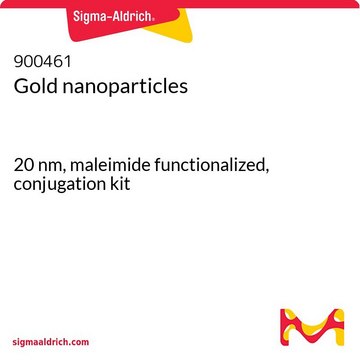741965
Gold nanoparticles
20 nm diameter, OD 1, stabilized suspension in citrate buffer
Synonym(s):
Au NP, Gold Colloid
About This Item
Recommended Products
Quality Level
form
nanoparticles
suspension
contains
Proprietary Surfactant as stabilizer
concentration
~6.54E+11 particles/mL
OD
1
diameter
20 nm
λmax
518-522 nm
PDI
<0.2
storage temp.
2-8°C
SMILES string
[Au]
InChI
1S/Au
InChI key
PCHJSUWPFVWCPO-UHFFFAOYSA-N
Looking for similar products? Visit Product Comparison Guide
General description
Application
- neutrophil labeling for monitoring the effect of different drugs
- immobilization of proteins for biosensor applications
- nano-carrier for drug delivery system for the release of hydrophobic drugs.
This material is highly monodisperse (<12% variability in size and shape), and provides significantly improved surface reactivity. Applications include Surface Enhanced Raman Lables, Sensing/Detection, Biological Targeting, Plasmonics and Electronics.
Legal Information
Storage Class
12 - Non Combustible Liquids
wgk_germany
nwg
flash_point_f
Not applicable
flash_point_c
Not applicable
Choose from one of the most recent versions:
Already Own This Product?
Find documentation for the products that you have recently purchased in the Document Library.
Customers Also Viewed
Articles
Steven J. Oldenburg, Ph.D. provides an overview of lateral flow diagnostic assays and discusses the use of ultra-bright reporter particles based on the unique optical properties of gold nanoshells that significantly increase the sensitivity of lateral flow immunoassays.
Sustainable, environment-friendly, and clean energy sources with sufficiently high production efficiency for practical application are highly desirable to meet the energy challenge of the 21st century due to the world′s increasing energy demand.
Gold (Au) nanoparticles have tunable optical and electronic properties and are used in a number of applications including photovoltaics, sensors, drug delivery & catalysis.
Gold (Au) nanoparticles have tunable optical and electronic properties and are used in a number of applications including photovoltaics, sensors, drug delivery & catalysis.
Our team of scientists has experience in all areas of research including Life Science, Material Science, Chemical Synthesis, Chromatography, Analytical and many others.
Contact Technical Service


